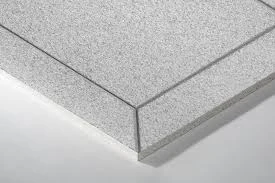10 月 . 12, 2024 09:17 Back to list
Benefits of Mineral Wool Ceiling for Improved Insulation and Soundproofing Solutions
The Benefits of Mineral Wool Ceiling A Comprehensive Guide
In the world of building materials, mineral wool has gained significant attention for its versatile applications and outstanding performance characteristics. One of its prominent uses is in ceiling systems. Mineral wool ceiling tiles offer a range of benefits, making them a popular choice for both commercial and residential buildings. This article will explore the advantages of mineral wool ceilings, their applications, installation, and maintenance considerations.
What is Mineral Wool?
Mineral wool, also known as rock wool or stone wool, is a fibrous material made from natural minerals or synthetic products. It is created by melting rock or other materials at high temperatures and then spinning them into fine fibers. This unique structure provides mineral wool its excellent thermal and acoustic insulation properties, fire resistance, and durability.
Advantages of Mineral Wool Ceilings
1. Thermal Insulation
One of the most significant advantages of mineral wool ceilings is their thermal insulation capabilities. The air pockets trapped within the fibers of mineral wool provide excellent resistance to heat transfer. This means that buildings equipped with mineral wool ceilings can maintain stable indoor temperatures, reducing reliance on heating and cooling systems. Consequently, this leads to lower energy consumption and utility bills, promoting sustainability.
2. Acoustic Performance
Noise control is a critical consideration in building design, especially in places like offices, schools, and healthcare facilities. Mineral wool ceiling tiles have excellent sound-absorbing qualities, making them an ideal choice for environments where noise levels need to be managed. They can help reduce echoes and reverberation, creating a more comfortable and productive space for occupants.
3. Fire Resistance
Fire safety is paramount in any construction project. Mineral wool is inherently non-combustible due to its natural composition. It has a high melting point and does not emit toxic fumes when exposed to fire, making it an ideal choice for ceilings. Building codes often require fire-resistant materials in specific applications, and mineral wool ceilings can help meet those standards while enhancing the overall safety of a structure.
4. Environmental Sustainability
For environmentally-conscious builders and owners, mineral wool ceilings offer a sustainable choice. Mineral wool is produced from natural or recycled materials, and the manufacturing process generates minimal waste. Moreover, mineral wool is fully recyclable at the end of its life cycle, reducing landfill waste and contributing to a circular economy. Choosing mineral wool ceilings aligns with green building practices, making them suitable for LEED certification and other sustainable building standards.
mineral wool ceiling

Applications
Mineral wool ceilings are suitable for a variety of applications, including
- Office Buildings Creating an acoustically comfortable environment that fosters productivity. - Healthcare Facilities Providing quiet spaces, essential for patient recovery and comfort. - Educational Institutions Enhancing learning environments by minimizing noise distractions. - Industrial Spaces Offering a fire-resistant solution that complies with safety regulations.
Installation Considerations
Installing mineral wool ceilings requires careful planning and careful handling. While the installation process is relatively straightforward, here are some essential considerations
1. Grid System Mineral wool ceiling tiles are typically installed in a suspended grid system. Ensure that the grid is securely anchored and level to support the weight of the tiles.
2. Cutting and Fitting When cutting mineral wool tiles to fit around lights or vents, use a sharp utility knife for clean edges. Wear protective gear to avoid inhaling any fibers during cutting.
3. Moisture Management Mineral wool is resistant to moisture; however, it’s essential to maintain proper humidity levels in the installation area to prevent mold growth.
Maintenance
Mineral wool ceilings require minimal maintenance. Regular cleaning with a soft brush or vacuum can keep tiles looking fresh. In case of damage or stains, individual tiles can be replaced without having to overhaul the entire ceiling system.
Conclusion
Mineral wool ceilings prove to be a superior choice for a variety of building types due to their thermal insulation, acoustic performance, fire resistance, and environmental sustainability. By understanding their benefits and considering them in design and renovation projects, builders and property owners can create safer, quieter, and more energy-efficient spaces. Whether looking to meet specific building codes or seeking to enhance comfort and sustainability, mineral wool ceilings present an excellent solution.
-
Revolutionizing Interior Design with Ceilings t grid Suspended SystemNewsOct.29,2024
-
Revolutionizing Ceiling Design with ceiling access panel with Gypsum Tile WaterproofNewsOct.29,2024
-
Revolutionizing Interior Design with PVC Gypsum Ceiling: A Comprehensive GuideNewsOct.29,2024
-
Elevating Interior Design with High quality Mineral Fiber Ceiling TilesNewsOct.29,2024
-
Revolutionizing Interior Design with PVC Gypsum Ceiling: A Comprehensive GuideNewsOct.29,2024
-
Elevating Interior Design with High-Quality Mineral Fiber Ceiling Tiles: A Comprehensive GuideNewsOct.29,2024







